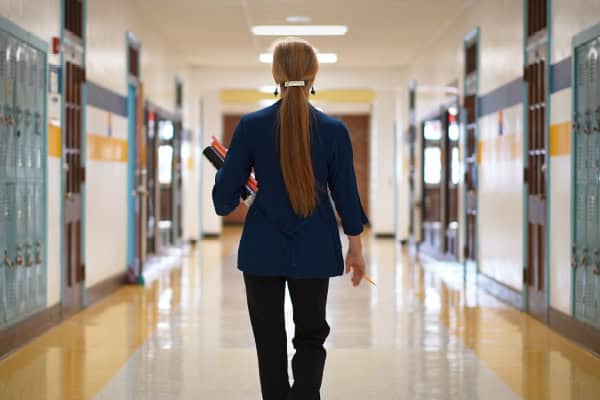Teacher turnover has hit new highs across the U.S., morale is low and schools are facing shortages as they seek to hire more educators, according to The 74. At the same time, the latest data suggests that public schools employ more teachers than they did before the pandemic. Thanks in part to strong state budgets and an infusion of federal funds, districts had about 20,000 more teachers in 2021-22 than they did five years earlier (a gain of 0.7%).
Meanwhile, those same schools were serving 1.9 million fewer students (a decrease of 4%). Those declines are widespread, with 35 states and more than two-thirds of districts enrolling fewer students than they did five years before.
A comparison of enrollment and staffing trends makes clear that public schools collectively reduced their student-to-teacher ratios over the course of the pandemic. In fact, American public schools are on the cusp of hitting all-time lows in the number of students per teacher.
After screening out very small districts and those without sufficient data, The 74 examined staffing and enrollment trends for 9,800 districts, comparing federal data from 2021-22 — the most recent available — with 2016-17.
Many more districts serve fewer students per teacher than they did five years earlier. Overall, 72% of districts in the sample fell into one of these categories.
There are three ways a district can reduce its student-to-teacher ratio: 1) More teachers, fewer students; 2) Fewer teachers, fewer students; and 3) more students but even more teachers.
1) According to the latest federal data, enrollment in New York City, the nation’s largest district, fell by about 125,000 students (12.7%) from 2016-17 to 2021-22. Meanwhile, it employed 3.7% more teachers. New York City was one of 3,119 districts, or about one-third of the total in the sample, that had more teachers serving fewer students. This group also includes districts such as Elgin, Illinois; Worcester, Massachusetts; and Eugene, Oregon.
2) Another way to reduce student-teacher ratios is to downsize staff more slowly than enrollment falls. Slightly more than 2,300 districts (one-fourth of total in the sample) decreased their teacher counts less quickly than student enrollment fell. These districts have been making adjustments, but they may have to come into closer alignment in the years to come.
3) The last category is districts where enrollment is growing but teacher counts are rising even faster. The Katy Independent School District, near Houston, is representative of this group. Its staffing and enrollment lines were growing in parallel until the pandemic hit. Since then, student enrollment growth has slowed while staffing growth did not. All told, the district is now serving 17% more students than it did five years before but employs 22% more teachers.
About 1,600 districts (one-sixth of the sample) are following a similar trajectory. These are typically faster-growing communities, and they include districts such as Irvine, California; Hays, Texas; and Ankeny, Iowa.
This analysis is capturing change over time, and it’s not meant to pass judgment on any particular district’s staffing levels at any given point in time. It’s possible that a district was understaffed in 2016-17 and remained so in 2021-22.
Some may cheer the increased staffing levels as one potential solution to getting kids back on track after the pandemic. But research on class size reductions suggests their success depends on a variety of factors. And they can be expensive. Recent estimates of a law passed last year mandating low class sizes in New York City pegged the additional staffing costs at $1.6 billion a year.
Analysis is limited to teachers because they are the staffers for whom districts have the most complete data, and teaching positions have been more stable than other types of staffing within schools. Although the data in this piece ends in 2021-22, the trends have continued since then — student enrollments are projected to continue to fall nationally, while public schools have only added to their payrolls over the last year.
This analysis gives a sense of how communities’ teacher staffing levels have changed due to the pandemic. It may also help identify districts that are most in danger of layoffs in the coming years, if they were using one-time federal relief dollars to avoid making layoff decisions or to bring in additional educators to help students get back on track.
Ultimately, a district’s funding is at least partially tied to how many students it serves, and the reductions in per-student staffing levels over the last few years may be unsustainable at current levels.
The 74





